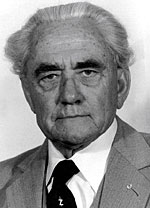
Contents
View Professor Sam Carey's photo gallery
You can order the DVD from the Academy for $15 (including GST and postage)
Professor Sam Carey was interviewed in 2000 for the Australian Academy of Science's '100 Years of Australian Science' project funded by the National Council for the Centenary of Federation. This project is part of the Interviews with Australian scientists program. By viewing the interviews in this series, or reading the transcripts and extracts, your students can begin to appreciate Australia's contribution to the growth of scientific knowledge.
The following summary of Carey's career sets the context for the extract chosen for these teachers notes. The extract covers the 1957 Continental Drift Symposium, which highlights Carey's interest in tectonics and continental drift. Carey mentions some of the influential geologists who were interested in the idea of moving continents in the late 1950s. Use the focus questions that accompany the extract to promote discussion among your students.
Sam Carey was born in Campbelltown, NSW in 1911. He was educated at Canterbury Boys High School and the University of Sydney, gaining a BSc Hons (1933) and an MSc (1934). In 1939, he received a DSc from the University of Sydney for his work on the tectonic evolution of New Guinea and Melanesia.
Carey worked in the petroleum industry in New Guinea, then served with the Australian Infantry Forces (Z Special Force) from 1942-44. He became chief government geologist in Tasmania in 1944. In 1946 he was appointed foundation professor of geology at the University of Tasmania.
Carey supported the theory of continental drift, explaining the movement of the continents by means of a model in which oceanic crust was formed at mid-ocean ridges and old oceanic crust underwent subduction at deep ocean trenches. The University of Tasmania became a leading university in tectonics and in 1957 Carey organised the Continental Drift Symposium, which influenced many scientists about the importance of continental drift. With the development of the plate tectonic theory, the idea of continental movement became widely accepted. Carey was also an advocate of the idea of an expanding Earth. He first put forward this hypothesis in 1956 and organised a symposium about it in 1983. He retired from the University of Tasmania in 1976.
Carey was made an Officer of the Order of Australia in 1977 and became a Fellow of the Australian Academy of Science in 1989.
Attracting attention to tectonics
Interviewer: You were interested in tectonics in the 1930s, and in Tasmania that became your specialty. Would you like to tell us a bit about the people you attracted to tectonics, people whose minds you changed?
I don't know whose minds I changed. I know some have changed mine. One of the people that greatly affected me was Harry Hess, a professor from Yale. He came to Tasmania and invited me to go to Yale. I had a year as professor at Yale, and during that time I lectured at practically every other university in the United States – I'd been invited around.
And then you attracted some students from Yale to Tasmania.
Yes, a few came – Kugler, Jan Smith, some others.
Tasmania was, because of your influence, a leading university in tectonics. In 1957 you had the Continental Drift Symposium. Would you like to talk about how you put that symposium together and some of the people you brought to it?
Oh well, I thought it was the right time to have a symposium on structural geology and tectonics, and we had one. Some people wanted to come but couldn't. An important man who did come was Longwell, from Yale. That resulted in my being invited to Yale as professor.
That symposium was very, very important. By pulling all of those people together, you started to have an influence in tectonics on the rest of the world. The English-speaking world had not really taken on the idea of continental drift.
They did then. The symposium is still quite heavily quoted, and they made reprints of the volumes – just recently, another reprint.
Dropping anchor in the right place
Of the main characters who came to that 1957 meeting, you've referred to Chester Longwell. Was Tuzo Wilson there? I think you had a big influence on him.
He was invited to the meeting but I don't think he was there. I probably did have an influence on him. He resented it at first and we quarrelled academically on a number of things. But he came round.
Another important person you met was Lewis Weeks, at Princeton University. It was Weeks who put Esso and BHP on to the exploration in Gippsland Basin, which has contributed enormously to Australia's oil and gas production. He has said that you drew a map of projected anticlines out into Gippsland Basin for him in 1959.
I remember Lewis Weeks very well. I certainly influenced him, and he influenced me.
It is important for professors to know the leaders in other universities, so they can send their students there, but a lot of our professors don't. They haven't been there themselves. I don't know how you can arrange for university men to go round the other universities and see what they are doing. They do so now via literature.
An edited transcript of the full interview can be found at http://www.science.org.au/scientists/interviews/c/sc.
Focus questions
Select activities that are most appropriate for your lesson plan or add your own. You can also encourage students to identify key issues in the preceding extract and devise their own questions or topics for discussion.
continental drift
structural geology
tectonics
© 2025 Australian Academy of Science